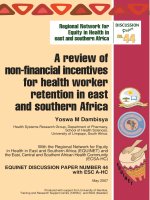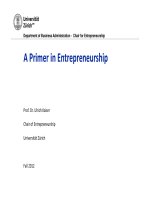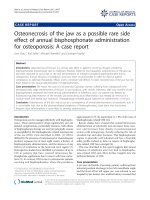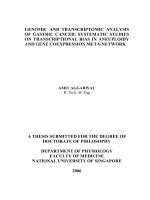Analysis of farmer’s perception for bio-pesticides: A case in chitradurga and Davanagere districts, India
Bạn đang xem bản rút gọn của tài liệu. Xem và tải ngay bản đầy đủ của tài liệu tại đây (393.93 KB, 8 trang )
Int.J.Curr.Microbiol.App.Sci (2019) 8(2): 2449-2456
International Journal of Current Microbiology and Applied Sciences
ISSN: 2319-7706 Volume 8 Number 02 (2019)
Journal homepage:
Case Study
/>
Analysis of Farmer’s Perception for Bio-pesticides: A Case in
Chitradurga and Davanagere Districts, India
G. Anupama1*, M. Avinash2, K.K. Das3 and N. Ashoka4
1
Horticulture Training center, Munirabad, Koppal, Karnataka, India-583233
2
College of Horticulture, Bengaluru, Karnataka, India- 560065
3
Swami Keshwanand Rajasthan Agricultural University, Bikaner, Rajasthan, India
4
Department of Agricultural Economics, College of Horticulture, Munirabad,
Koppal, Karnataka, India-583233
*Corresponding author
ABSTRACT
Keywords
Bio-pesticides,
Farmers, Market,
Purchase, Sales and
utilization
Article Info
Accepted:
18 January 2019
Available Online:
10 February 2019
Repeated exposure to agro-chemical pesticides may increases the pesticide accumulation
in food chain and adversely affect on human and environment. Hence, part of farming
community shifting from chemical inputs to bio-inputs. In this regard, this study was
conducted to know the extent of awareness, usage pattern, product differentiation, factors
affecting and purchase pattern of bio-pesticides in Chitradurga and Davanagere districts in
Karnataka state. The data pertaining to this study was collected with the help of pre-tested
questionnaire during the agricultural year 2018. The results of the study indicated that, the
training programmes conducted by the Scientists of Krishi Vignana Kendra, Hiriyur
provided the information on usage of bio-pesticides to farming community to the
maximum extent (40.67%) followed by Agricultural Officers (18.26%). Many of the crop
plants are prune to soil borne diseases and this factor made farmers to opt for biopesticides to maintain sustain soil health. Sixty for per cent of the respondents differentiate
the product with the help of brand name and followed by symbol (25.83%). Majority of
respondents (70.83%) opinioned that bio-pesticides are easily available as market network
is well established. Majority of farmers purchase the bio-pesticides after sowing as many
farmers are using bio-pesticides for perennial crops. The study also specified that, there is
vast scope for the sellers to deliver the product at door steps of farmer’s field as
telemarketing is an emerging market.
Introduction
Use of pesticide has surely added towards
improving agricultural production, thus
increasing agricultural income. However,
haphazard utilization of artificial chemical
pesticides has adversely affected human
health and environment and has also
enhanced development of pesticide resistance
among pest species. Farmer’s suicides in
Karnataka are attributed to untreated mental
illness. Depression arising from repeated
exposure of agro-chemicals, pesticides may
increase the risk for mood disorders and
2449
Int.J.Curr.Microbiol.App.Sci (2019) 8(2): 2449-2456
ultimately suicide (Purnanand, 2011).
Recently, the World Health Organization’s
(WHO) estimate indicated that, 25 million
cases of acute occupational pesticide
poisoning in developing countries and 20,000
deaths world‐wide each year (Ezhil Vendan,
2016).
Therefore, there has been a rising demand for
foodstuff and quality in recent decades, as
reflected in the stiff safety rules on imports of
products and severe set of laws on the amount
of pesticide residues on farm products. Biopesticides are natural materials derived from
animals, plants, and bacteria, as well as
certain minerals, which are used for pest
control
(EPA.
Bio-pesticides,
2017).
Currently, bio-pesticides consist of a small
share of the total crop safety market
internationally, with a value of about $3
billion worldwide, accounting for just 5 per
cent of the total crop protection market
(Marrone, 2014; Olson, 2015). Although biopesticide use at a global scale is increasing by
almost 10 per cent every year (Kumar, 2016),
it appears that the global market must increase
further in the future if these pesticides are to
play a visible role in substituting for chemical
pesticides and reducing the current overreliance on them.
Currently, there are fewer bio-pesticide active
substances registered in the EU than in the
US, India, Brazil, or China (Christos and
Spyridon, 2018). However, bio‐pesticides
may represent about 4.2 per cent of the
overall pesticides market in India (Das, 2014).
Globally, bio-pesticides production is 4.5 per
cent and in USA it is 6 per cent, whereas in
India, it accounts only 3 per cent of the total
chemical pesticides production. Presently,
only 12 types of bio-pesticides including
neem based and microbial based formulations
are registered under the Insecticide Act, 1968
in India (EzhilVendan, 2016).
Even though the potential demand for biopesticides is very high, the real demand from
the farming community is very low. There is
lack of awareness among farmers about the
benefits of this low cost product. There is also
lack of proper marketing network, lack of
awareness among marketing personnel and
lack of promotional efforts in right direction
etc. In this regard, this study was conducted
dynamics of bio-pesticide usage in
Chitradurga and Davanagere region in central
Karnataka.
Materials and Methods
To accomplish the objectives of the present
study, Chitradurga and Davanarere districts
were selected because these districts
represents most of the suitable climatic and
geographical conditions that are prevailing in
the state and also enjoyed considerable part in
production of agricultural and horticultural
crops. In the next stage, list of two talukas
from each district were selected viz.,
Hosadurga and Hiriyur from Chitradurga
district and Davanagere and Channagiri from
Davanagere district using bio-pesticides was
prepared in consultation with the horticulture
and agriculture officials in the districts. From
the list of talukas, two villages from each
taluka were randomly selected for the study.
The primary data pertaining to the year 2016
were collected from 120 farmers’ respondents
(60 from each district) with the help of pretested questionnaire.
Analytical tools like tabular analysis and
simple average were used indicating the
characteristic like buying behavior, brand
preference, sales strategy, marketing cost,
constraints, etc.
Results and Discussion
The findings of the present study have been
presented under following heads:
2450
Int.J.Curr.Microbiol.App.Sci (2019) 8(2): 2449-2456
Sources of information for bio-pesticides
availability
Sources of information pertaining to the biopesticides availability to the farmers are
presented in Table 1. The result revealed that
most of the farmers came to know about
availability of suitable bio-pesticide from
Scientists of KVK, Hiriyur (40.67%) followed
by Agriculture Officers (18.26%), Dealers
/Retailers (17.43%), Company marketing
officers
(9.43%),
Friends/relatives/
Progressive farmers (8.30%), Advertisement
(3.32%) and other sources of information
which accounted to only 2.49 per cent. This
result revealed that Scientists of KVK,
Hiriyur are the main sources of information
(40.67%) as Scientists have conducted many
method and result demonstration training
programme as a part of their extension
activities in both the districts. Similar
observations were made by Gururaj (2007)
with regard to cotton and cabbage in North
Karnataka. In addition to this, scientists have
delivered series of lecture during the farmer’s
meet along with literature distribution. The
college is situated at border of the both
district hence intervention of scientists is at
maximum extent.
opting for soil borne bio-pesticides as many
of the plant diseases are soil borne in nature.
In addition to this, increasing cost of chemical
pesticides and to maximize the total returns
were other two important factors made
farmers to use bio-pesticides.
Product differentiation of bio-pesticides
The degree of product differentiation of biopesticides by farmers among the various
brands of bio-pesticides from different
producers is given in Table 3. It is clear from
the table that the 65.00 per cent of
respondents differentiate the products from
their brand names, 25.83 per cent from brand
symbol, 4.17 per cent by colour of packaging,
3.33 per cent by shape of the packaging and
1.67 per cent from size of the packaging.
Since majority (66.67%) of the farmers using
bio-pesticides for fruit crops and fruit growers
are aware of different brands of bio-pesticides
available in the markets as they are literate
and undergone different training programmes
at different institutions. This result is in line
with (Yeledhalli et al., 2011) with respect to
marketing of bio-fertilizers in North
Karnataka.
Purchase pattern of bio-pesticides
Factors affecting the use of bio-pesticides
Different factors influence for usage of biopesticides by the farmers is presented in Table
2. It is noticed from the table that sustaining
the soil health by managing the soil borne
pathogens was the most perceived factor
(35.83%) followed by increased cost of
chemical pesticides (18.33%), increasing the
total returns (10.83%), to get better quality of
produce (8.33%). Environmental concern
(6.67%), reducing the cost of cultivation
(5.83%), motivation from neighbor farmers
(3.33%) and motivation by media (0.83%)
were identified as other factors for use of biopesticides. Majority of the farmers were
It is noticed from the Table 4 that 70.83 per
cent of farmers perceived that the biopesticides are easily available and 29.17 per
cent perceived its availability is difficult. This
is mainly because of well established
marketing network of bio-pesticides, as many
public and private firms are engaged in
producing and marketing of bio-pesticides in
these
districts.
With
respect
to
certified/standardized quality of bio-pesticides
60.83 per cent of the respondents were aware
of certified/standardized quality of biopesticides while purchasing and 39.17 per
cent of the farmers were not aware of quality
of bio-pesticides. Sufficient technical
2451
Int.J.Curr.Microbiol.App.Sci (2019) 8(2): 2449-2456
knowledge of the farmers on quality aspects is
attributed the reason. Nearly 65 per cent of
farmers purchase the bio-pesticides after the
sowing as 66.67 per cent of the farmers using
the bio-pesticides for perennial / fruit crops
(Table 5). Almost 35 per cent of the
respondents were purchasing bio-pesticides at
the sowing time and 6.67 per cent during land
preparation. This was because of their
convenience at the time of purchasing other
inputs, as 33.37 per cent of bio-pesticides
were using for annual crops. About purchase
behavior, 54.17 per cent of farmers purchased
the intended product only, whereas 33.33 per
cent respondents purchase with other inputs.
This is because to control soil borne diseases
organically. About 12.50 per cent farmers get
the produce delivered at their door step
through E-commerce (online shopping).
Table.1 Sources of information of bio-pesticides availability N=60+60=120
Sl.
No.
Particulars
Chitradurga District
Frequency
Per cent
1 Agriculture officers /
KSDA / RSK
2 Krishi Vignana
Kendra, Hiriyur
3 Company marketing
officers
4 Dealers / Retailers
5 Advertisements
6 Friends / Relatives /
Progressive farmers
7 Others (Specify)
Davanagere District
Frequency
Per
cent
12
20.00
10
16.67
27
45.00
22
6
10.00
10
2
4
1
Aggregate (Overall)
Frequency
Per cent
22
18.26
36.67
49
40.67
5
8.33
11
9.43
16.67
3.33
6.67
11
2
6
18.33
3.33
10.00
21
4
10
17.43
3.32
8.3
1.67
2
3.33
3
2.49
Table.2 Reasons for using bio-pesticides or factors influencing N=60+60=120
Sl.
No.
Particulars
Chitradurga District
Frequency Per cent
1
Increasing cost of
chemical pesticides
Sustained soil health /
For managing soil
borne pathogens
Reduced cost of
cultivation
Better quality of
produce
Increasing returns
Motivation from
neighboring farmers
Environmental concern
Easy of operation
Motivation by media
10
2
3
4
5
6
7
8
9
Aggregate (Overall)
Frequency Per cent
16.67
Davanagere District
Frequency Per
cent
12
20.00
22
18.33
22
36.67
21
35.00
43
35.83
4
6.67
3
5.00
7
5.83
3
5.00
7
11.67
10
8.33
6
3
10.00
5.00
7
1
11.67
1.67
13
4
10.83
3.33
4
4
1
6.67
6.67
1.67
4
5
0
6.67
8.33
0.00
8
9
1
6.67
7.50
0.83
2452
Int.J.Curr.Microbiol.App.Sci (2019) 8(2): 2449-2456
Table.3 Product differentiation of bio-pesticides N=60+60=120
Sl.
No.
Particulars
Chitradurga District
Davanagere
District
Aggregate (Overall)
Frequency
Per cent
Frequency
Per
cent
Frequency
Per cent
1 Brand name
38
63.33
40
66.67
78
65.00
2 Brand symbol
16
26.67
15
25.00
31
25.83
3 Colour of
package
3
5.00
2
3.33
5
4.17
4 Shape of package
2
3.33
2
3.33
4
3.33
5 Size of package
1
1.67
1
1.67
2
1.67
6 Others (Specify)
0
0.00
0
0.00
0
0.00
Table.4 Purchase pattern of bio-pesticides N=60+60=120
Sl.
No.
Particulars
Chitradurga
District
Frequency Per
cent
Davanagere
District
Frequency Per
cent
Aggregate (Overall)
Frequency Per
cent
1 Are bio-pesticides available easily
Yes
40
66.67
45
75.00
85
70.83
No
20
33.33
15
25.00
35
29.17
2 Whether you purchase certified / standard bio-pesticides
Yes
35
58.33
38
63.33
73
60.83
No
25
41.67
22
36.67
47
39.17
At the time of land
preparation
3
5.00
5
8.33
8
6.67
At the time of sowing
15
25.00
20
33.33
35
29.17
After sowing
42
70.00
35
58.33
77
64.17
Buy intended product only
35
58.33
30
50.00
65
54.17
Along with other inputs
20
33.33
20
33.33
40
33.33
Door delivery
5
8.33
10
16.67
15
12.50
3 Purchase time of bio-pesticides
4 How you brought bio-pesticides
2453
Int.J.Curr.Microbiol.App.Sci (2019) 8(2): 2449-2456
Table.5 Utilization patter of bio-pesticides N=60+60=120
Sl.
No.
1
2
3
4
5
6
Particulars
Fruit crops
Vegetable crops
Cereals crop
Pulse crops
Oil seed crops
Commercial crops
Chitradurga District
Frequency
Per cent
38
12
5
2
0
3
63.33
20.00
8.33
3.33
0.00
5.00
Davanagere
District
Frequency Per
cent
42
70.00
8
13.33
5
8.33
2
3.33
1
1.67
2
3.33
Aggregate (Overall)
Frequency
Per cent
80
20
10
4
1
5
66.67
16.67
8.33
3.33
0.83
4.17
Table.6 Bio-pesticides application pattern N=60+60=120
Sl.
No.
Particulars
Chitradurga District
Frequency Per cent
1 Seed Treatment
With Jaggary solution
With sugar solution
With water
2 Soil application
Applied directly to the
soil
Mixed with FYM/cow
dung/Compost
Mixed with other
pesticides
3 Liquid form
Seedling dip
Fertigation method
Aerial spray
Davanagere
District
Frequency Per
cent
Aggregate (Overall)
Frequency Per cent
54
4
2
90.00
6.67
3.33
55
3
2
91.67
5.00
3.33
109
7
4
90.83
5.83
3.33
10
16.67
8
13.33
18
15.00
50
83.33
52
86.67
102
85.00
0
0.00
0
0.00
0
0.00
10
18
32
16.67
30.00
53.33
12
25
23
20.00
41.67
38.33
22
43
55
18.33
35.83
45.83
Utilization pattern of bio-pesticides in
different cropping enterprises
Utilization pattern of bio-pesticides in study
area is presented in Table 5. It is clear that
bio-pesticides used more in Fruit crops
(66.67%) followed by Vegetable crops
(16.67%), Cereals (8.33%), Pulse crops
(3.33%), Commercial crops (4.14%) and Oil
seed crops (0.83%). The reasons attributed for
more usage of bio-pesticides to fruit crops are
they are perennial in nature and hence they
more prone for soil borne pests and diseases.
Hence, locally isolated bio-pesticide were
more effective against soil borne pathogens
especially in high value crops like fruit crops.
Pomegranate is dominated fruit crops in the
study area and farmers of these districts apply
2454
Int.J.Curr.Microbiol.App.Sci (2019) 8(2): 2449-2456
bio-pesticides
(Trichoderma
sp.
and
Pseudomonas sp.) against bacterial blight and
wilt with intention to produce organically.
Farmers in the study area opinioned that KVK
Hiriyur is supplying locally isolated
Trichoderma and Pseudomonas stains which
are most effective against soil born diseases
particularly in these regions.
Bio-pesticides application pattern
The method of application of bio-pesticides is
vary from farmer to farmer and is shown in
Table 6. It is evident from the table that seed
treatment with jaggery solution is more
(90.83%) as jaggery is cheaply available and
effective and very few (5.38%) farmers are
using bio-pesticides with sugar solution. With
respect to soil application, 15 per cent of
respondents applied directly to the soil and
majority (85%) farmers used bio-pesticide
after mixture with Farm Yard Manure / Cow
dung / Compost. This is because biopesticides are living organism which
multiplies well with organic matter. In liquid
form, 18.33 per cent of farmers practiced
seedling dip method especially for vegetable
crops, because tender seedling can easily
absorbs more bio-pesticides in liquid
formulation and 35.83 per cent farmers using
bio-pesticides through drip irrigation method.
Majority of respondents are spraying the biopesticides over crop plants especially for
perennial crops. This is because of their
convenience and as per the recommendation
of Scientists of KVK and College of
Horticulture, Hiriyur in various training
programmes. Yeledhalli et al., (2011) also
reported similar observation in case of
biofertilizers application in Karnataka.
Policy implication
In spite of increasing demand for chemical
pesticides, the agricultural production in the
study area is slowly shifting back to organic
agriculture due to more human and soil health
conscious. The extension activities of
Scientist of KVK and College of Horticulture,
Hiriyur are the most preferred media of
creating the awareness of bio-pesticides. The
results indicated that, company marketing
officers involved around only nine per cent
for advertisements for promoting their
products. Hence, it is recommended that
company marketing officers should be very
aggressive in the market to penetrate their
products in the minds of customers. There is
enough scope to promote the products from
the dealers/ retailers as they are the primary
source of information and consultant to the
farming community through the training
programs.
The results indicated that meager amount of
bio-pesticides are using for oilseed and
commercial crops. Hence, extension programs
may drag attention on role of bio-pesticides
on these crops for improving yield and
managing soil borne diseases.
References
Christos, A., Damalas, I. D., Spyridon, D. K.
2018. Current Status and Recent
Developments in Bio-pesticide Use.
Agriculture. 8(13).
Das, S. K.2014. Recent development and
future of botanical pesticides in India.
Popular Kheti. 2:93‐99.
EPA. Bio-pesticides. 2016. Available online:
www.epa.gov/pesticides/biopesticides (accessed on 25 August
2018).
EzhilVendan, S. 2016. Current Scenario of
Bio-pesticides and Eco-Friendly Insect
Pest Management in India, South
Indian J. Biol. Sci., 2(2): 268‐271
Gururaj Honnunasi. 2007. Bio-pesticide
marketing and usage in north
Karnataka a case study of Belgaum
district. M. B.A. (ABM) Thesis,
2455
Int.J.Curr.Microbiol.App.Sci (2019) 8(2): 2449-2456
University of Agricultural Sciences,
Dharwad.
Kumar, S., Singh, A. 2016. Bio-pesticides:
Present status and the future prospects.
Journal of Fertilizers and Pesticides.
6:129-134.
Marrone, P. G. 2014. The market and
potential for bio-pesticides. In Biopesticides: State of the Art and Future
Opportunities; Gross, A.D., Coats,
J.R., Duke, S.O., Seiber, J.N., Eds.;
American
Chemical
Society:
Washington, DC, USA. pp. 245–258
Olson, S. 2015. An analysis of the biopesticide market now and where is
going. Outlooks Pest Manag. 26:203–
206.
Purnanand, N. S., Malakajappa, G. H. 2011.
Agrarian Distress and Farmers
Suicides in Karnataka: Strategy for
Prevention, Int. Multidisciplinary Res.
J., 1(3): 1-5.
Yeledhalli, R. A., Pinjar Peersab, M., Ashoka,
N. 2011b. Marketing management of
biofertilizers in North Karnataka.
Green Farming. 2(2):166-169.
Yeledhalli, R. A., Pinjar Peersab, M., Ashoka,
N., Kuldeep, C. 2011a. Dynamics of
Biofertilizers in North Karnataka,
Agriculture Update. 6(2):1-4.
How to cite this article:
Anupama, G., M. Avinash, K.K. Das and Ashoka, N. 2019. Analysis of Farmer’s Perception
for Bio-pesticides: A Case in Chitradurga and Davanagere Districts, India.
Int.J.Curr.Microbiol.App.Sci. 8(02): 2449-2456. doi: />
2456









